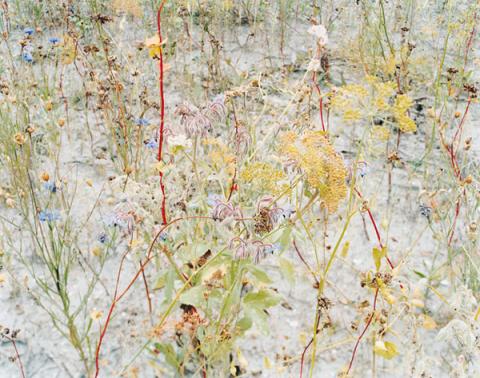Wout Berger
Ruigoord (2002, photography)
Faculty Club

Wout Berger (1941) is a photographer who makes extensive use of the technical camera, opting for extraordinarily high vantage points. He is one of the first photographers in the Netherlands to specialize in making color prints himself. His work is inspired by late 20th century American landscape photography. The two works in the Faculty Club were made in Ruigoord, a former island near Amsterdam.
In 1968, it was decided that the area around Ruigoord would become an industrial zone. The landowners of the Houtrakpolder were bought out and the residents were forced to move while the area around Ruigoord was filled with sand. It was there, in the yellow sand where no new life is expected, that Berger photographed the unanticipated flowering of all sorts of plants and weeds.
His interest in unusual landscapes had previously been evident in the photo series Giflandschap about contaminated soils in the Netherlands. These photographs from the 1990s showed "how deceptive reality can be: places that are heavily poisoned often look idyllically beautiful." Berger visited a large number of locations in the Netherlands in 1992, and in 2017, he photographed about fifty again from the same vantage point. The combination of both photographs showed "how the landscape can change in the space of a quarter of a century—or not at all. The result of change processes that often occur imperceptibly in everyday life is now visible in one (albeit double) glance."
Wout Berger's work is included in many domestic and foreign collections, including Boijmans van Beuningen, Stedelijk Museum Amsterdam, De Lakenhal Leiden, and the Caldic Collection.
More about history and academic heritage
The Tilburg University academic heritage is a very diverse set of archives, visual materials, collections, devices, recorded stories, et cetera that relate to the history of the university.